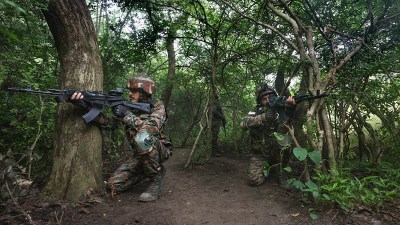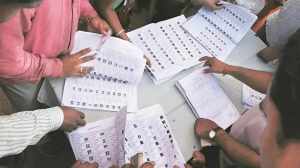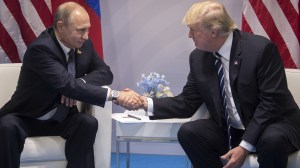‘Delayed and ineffective’: Punjab political leaders draw flak in border areas for responses amid India-Pakistan conflict
While Chief Minister Bhagwant Mann has yet to visit any border village of Punjab after the India-Pakistan tensions, Prime Minister Narendra Modi paid a visit to the Adampur Indian Air Force station on Tuesday.
 A Border Security Force (BSF) soldier stands guard near India-Pakistan border check post, near Amritsar. (PTI)
A Border Security Force (BSF) soldier stands guard near India-Pakistan border check post, near Amritsar. (PTI)As the tensions following the India-Pakistan conflict have eased, the spotlight has turned to how political parties responded to the situation in Punjab, which has a 553-km international border spanning six districts with the neighbouring country.
While the Union government initiated Operation Sindoor in retaliation for the Pahalgam terrorist attack of April 22, the state’s political leaders were criticised for their “delayed” and at times “ineffective” responses to the situation on the ground.
While Chief Minister Bhagwant Mann has yet to visit any border village of Punjab, Prime Minister Narendra Modi paid a visit to the Indian Air Force station at Adampur on Tuesday.
Mann was supposed to meet the injured victims of a Pakistani drone attack in Ludhiana’s Dayanand Medical College and Hospital on Sunday and Monday, but the visits were cancelled owing to unexplained reasons.
Three people were injured in the drone attack in Khai Femeki village of Ferozepur district. Of them, one Sukhwinder Kaur, 50, who had suffered 100 per cent burns, died early on Tuesday, while her husband Lakhwinder Singh, 55, is battling for his life with 72 per cent burns. Their son Jaswant Singh’s condition is stable at Ferozepur’s Baghi Hospital.
Delayed action and absence of local leadership
Punjab’s border villagers have always had the threat of cross-border violence looming over them. However, the response from the state government, and particularly the ruling AAP, was perceived as slow and disconnected.
According to Karamjit Singh, a farmer from Pacca Chisti village in Fazilka district, the situation was handled poorly. “We were watching TV every day and we knew something big was coming, but the government was missing in action. The local MLAs, who should have been accessible to the constituents, were nowhere to be seen,” he said.
The village is in the Fazilka constituency of MLA Narinderpal Sawna, who visited a few areas on May 7, when people’s movement for safer places had already begun.
This disconnection between the people and their elected representatives was evident in the days following the Pahalgam attack. As tensions rose at the border, the state government’s response came in the form of a cabinet meeting on May 8. Ten ministers were assigned to visit the border districts at a time when red alerts had been issued across the state and markets were asked to stay closed and people to stay indoors.
Yet the ministers’ visits, scheduled for May 9, were called off as the situation was not conducive. However, this raised questions among villagers about the government’s commitment to the border region’s safety.
The administration was busy managing blackouts, while police were cautious about the possible drone attacks. Thus, handling ministers’ visits would have been an additional burden for the authorities, sources said.
On May 8, however, ministers Laljit Singh Bhullar and Harbhajan Singh ETO visited hospitals in Tarn Taran to take stock of the arrangements and markets to check the prices of essential items.
From May 10, when a ceasefire was announced, Chief Minister Mann and other state government officials were busy at the Nangal dam, raising the issue of water sharing with Haryana yet again.
Absence and criticism
Despite the tension, AAP legislators were often seen prioritising political events over the safety and security of their constituents. AAP MLAs including Ranbir Singh Bhullar visited the Gatti Rajoke belt in Ferozepur with two boats for possible evacuation on May 8, only after the villagers demanded them. Locals criticised this as a late intervention.
Contrast this with the actions of former chief minister Parkash Singh Badal in 2016, when border evacuation was ordered in October of that year. He visited the last villages on the border belt and took immediate steps to reassure villagers, even by visiting relief camps. Villagers, such as those from Pathankot, reflected on the differences in the leadership style. Jagmeet Singh from the Gatti Rajoke block said the government’s response in 2025 was far slower and less coordinated than in previous years.
Political parties divided
The Opposition Shiromani Akali Dal (SAD), led by Sukhbir Singh Badal, attempted to provide immediate relief, with the party’s president offering Shiromani Gurdwara Parbandhak Committee-managed gurdwaras as shelters. The 15 SGPC gurdwaras in the border belt were thus opened to the public. Though people did not use the gurdwaras as shelters, they were available in case they needed any.
A few BJP leaders such as Heera Sodhi and Ravi Karan Kahlon were seen actively engaging with the affected villagers in Ferozepur, Fazilka, Pathankot, and Gurdaspur. Heera Sodhi was the first one to visit a drone attack victim at a Ferozepur hospital on May 10.
On May 11, BJP state president Sunil Jakhar visited Ludhiana’s DMCH to meet two other victims of a Pakistani drone attack.
BJP spokesperson Pritpal Singh Baliawal said, “We had given lists to the respective deputy commissioners across the state of the persons who were interested to work as civil defence volunteers in every district and our workers were making sure to reach every location where a possible drone attack was happening or a drone had fallen. The idea was to boost the morale of the masses and ask if they needed any help.”
Gurdaspur MP Sukhjinder Singh Randhawa emerged as the most visible face in his constituency, meeting villagers near the zero-line and the city and encouraging them to stay strong. “Punjabis never fear wars, and we at the border have always fought battles. We want Pakistan to be crushed hard,” he said. He welcomed the ceasefire later.
Public sentiment and apathy
There was still widespread discontent among residents of the border districts. Many villagers felt that the government had failed to show up when they needed it the most. Ministers Laljit Singh Bhullar and Harbhajan Singh ETO made brief appearances on May 8, but their visits were overshadowed by the rising tensions. After the ceasefire was announced, their plans to visit border villages were abruptly cancelled, further alienating the locals.
Villagers in Habibke were particularly vocal, “Had the government given the option of relief camps, many of us would have shifted. But the authorities were mute spectators while we prepared to move to our relatives’ homes,” one of them said.
The political parties’ response also raised crucial questions about the state’s preparedness in handling cross-border crises. While politicians from various parties attempted to show solidarity with the people, their actions were often delayed or disconnected from the realities faced by the residents of the border districts.
As normalcy returns, the people of Punjab’s border areas remain cautious and sceptical. Their demand is simple: to ensure their safety, the government must prioritise their needs over political agendas and provide timely support during times of crisis.
They demand more than just symbolic visits and rhetoric from leaders they have elected to serve them.







